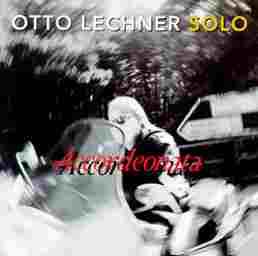
Program:
Accordeonata
Program:
Entrance
Die Wintersonnenwende -- Finster und bitterkalt
Die Wintersonnenwende -- Tanz mit der Hex'
3/4 Suite I
3/4 Suite II
3/4 Suite III
Crying Rhinoceros
Der Fuchs und die Ganse
Bosnia Suite I
Bosnia Suite II
Otto's Seven
Brother Ray
Auf der Galerie
Flut
Da Himmevoda
Caravan
Total Time: 47:51
Released in 1994
label: Extraplatte Musikproductions und Verlags GmbH (EX 204-2)
PO Box 2
A-1094 Vienna
Austria
Phone: +43/1/310 10 84
FAX: +43/1/310 03 24
extraplatte@blackbox.at
"If some frail, consumptive in the circus were to be urged around and around on an undulating horse for months on end without an insatiable public, whizzing along in her horse, throwing kisses, swaying from the waist, and if this performance were likely to continue in the infinite perspective of a drab future to the unceasing roar of the orchestra and hum of the ventilators, accompanied by ebbing and renewed swelling bursts of applause which are really steam hammers; then, perhaps, a young visitor to the gallery might race down the long stairs through all the circles, rush into the ring, and yell: Stop! against the fanfares of the orchestra still playing the appropriate music.
"But since that is not so; a lovely lady, pink and white, floats in between the curtains, which proud lackeys open before her; the ringmaster, deferentially catching her eye, comes toward her; the breathing animal devotion; tenderly lifts her up on the da pple-gray, as if she were his own most precious granddaughter about to start on a dangerous journey; cannot make up his mind to give the signal with his whip, finally masters himself enough to crack the whip loudly; runs along beside the horse, open-mouth ed; follows with a sharp eye the leaps taken by it's rider; finds her artistic skill almost beyond belief; calls to her with English shouts of warning; angrily exhorts the grooms who hold the hoops to be most closely attentive; before the great somersault lifts up his arms and implores the orchestra to be silent; finally lifts the little one down from her trembling horse, kisses her on both cheeks, and finds that all the ovation she gets from the audience is barely sufficient; while she herself, supported by him, right up on the tips of her toes, in a cloud of dust, with outstretched arms and small head thrown back, invites the whole circus to share her triumph-since that is so, the visitor to the gallery lays his face on the rail before him and, sinking into the closing march as into a heavy dream, weeps without knowing it."
(text by Franz Kafka, translated by Willa and Edwin Muir, recited by Otto Lechner in German with accordion accompaniment in track 13: Auf der Galerie)
Review by
Review by Henry Doktorski:
Otto Lechner shows what one can do with solo accordion and voice, and make it wonderfully exciting, contemporary, and relevant. Some of his music has a new-age flavor: Die Wintersonnenwende is a gorgeous harmonic progression repeated thrice with subtle variations which feature a tasteful use of tremolo (gently shaking the bellows with the hand while opening or closing the bellows in one direction) during the last repetition. In the same vein, Flut is a five minute 40 second etude of bellow-shaking non- functional chords subtly shifting note-by-note (chordal mutation) which takes us on a journey to a destination we cannot imagine until we get there.Most of the other pieces on the album have strong jazz influences (Caravan is by Duke Ellington), and still other pieces seem to have some pop, folk and classical music influence. Lechner wrote in the liner notes, "I was born in 1964, the year of the woo d dragon, in Melk an der Donau, a small town in Lower Austria. My father was no singer and my mother no violin player, which allowed me enough space for my own musical development. My first teacher was Jauerling -- pronounced Yau-er-ling -- (976 m). Th is mountain carries a transmitting station for all Austrian radio programs, and at the age of four I started to copy some folk songs that I heard on the radio with my little squeezebox. Soon I turned the dial to pop, jazz and classical music, and also di scovered the space between the stations."
Crying Rhinoceros is a rather happy-go-lucky pop tune, light and easy to listen to. On the other hand, Der Fuchs and die Ganse is a driving fusion/jazz/rock sounding piece which features a repeated note ostinato, parallel fifths and Lechner singing scat syllables. Track one, Entrance, also features scat singing -- in a whole tone scale, no less.
Track 13: Auf der Galerie is an interesting setting of a text by Franz Kafka; the only piece on the album which has a substantial atonal section. Himmevoda features some nice percussion work -- tapping on the accordion. I congratulate Otto Lechner for h is contribution to the accordion literature and I recommend this album for lovers of contemporary jazz/pop accordion music.
| About The Free-Reed Review |
| Invitation to Contributors / Submission Guidelines |
| Back to The Free-Reed Review Contents
Page |
| Back
to The Classical Free-Reed, Inc. Home Page |